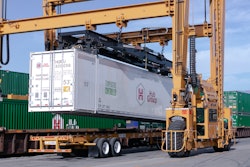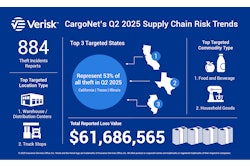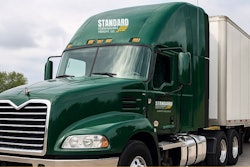Inventories are holding steady month-to-month in both used heavy-duty trucks and trailers, but compared to last year, there’s a clear decline in available units, according to a report from Sandhills Global. Reefers are seeing pricing strength, while dry vans and day cabs are under pressure in pricing and turnover.
The report noted that inventory levels in the U.S. heavy-duty truck market remained flat in June, slipping 0.33% month-over-month and declining 20.22% year-over-year. Used sleeper trucks recorded the sharpest shift, rising 8.56% month-over-month while posting the largest year-over-year drop at 27.23%.
Asking prices also moved sideways, with a modest 0.08% month-over-month decline and a 1.45% year-over-year decrease. The used day cab segment led the downward trend, as prices fell 1.58% from May and 6.32% compared to June 2024.
Auction values followed a similar pattern, declining 3.97% month-over-month and 1.67% year-over-year overall. Again, used day cabs showed the steepest declines, down 4.38% month-over-month and 9.94% year-over-year.
Trailer market
In the used semi-trailer market, Sandhills noted inventory levels remained relatively stable in June, ticking down 0.08% month-over-month and declining 9.61% year-over-year. Used reefers saw the largest month-over-month inventory increase at 4.38%, while used dry van trailers saw the largest year-over-year inventory decrease at 18.57%.
Asking values trended upward, rising 0.24% month-over-month but easing slightly by -0.73% year-over-year. The reefer trailer segment led month-over-month price growth with a 4.65% increase, while dry vans saw a significant 6.15% year-over-year decline.
Auction values moved sideways, slipping 2.15% month-over-month but increased 1.25% year-over-year. Used dry van trailers showed the largest decline, with values down 7.85% month-over-month and 6.14% year-over-year.
Fleet downsizing drives auction supply
Looking at J.D. Power’s July 2025 commercial vehicle market update report, director of specialty vehicles Chris Visser said three-year-old sleeper tractors returned to auctions in force in June. As is typically the case for June, auction activity picked up in volume while pricing moved lower.
Auction and retail markets split paths during the month. At auction, sales volume rose, but pricing declined. On dealers’ lots, inventory shrank slightly, while pricing edged upward.
Historically, June is a month of higher-volume and lower-pricing month at auctions. June 2025 followed seasonal behavior.
J.D. Power’s average pricing showed that late-model sleeper tractors declined across all tracked model years.
- Model year 2023: $64,992; $5,800 (8.2%) lower than May
- Model year 2022: $53,959; $5,685 (9.5%) lower than May
- Model year 2021: $35,504; $7,495 (17.4%) lower than May
- Model year 2020: $31,520; $3,056 (8.8%) lower than May
- Model year 2019: $22,588; $2,812 (11.1%) lower than May
At auctions in June, selling prices for 4- to 6- year-old trucks fell 11.8% from May, but were 11.8% higher than June 2024.
These prices still sit 8.2% higher than the pre-pandemic nominal figures (15.2% lower than that period when adjusted for inflation), and 73.1% above the late-2019 market low.
Last month, Visser noted a lag in expected volumes of three-year-old trucks hitting auctions. That volume finally appeared in June’s results, the report noted, with the highest volume of trucks of that age sold since September 2023.
“Fleet trades and downsizing appear to be a primary factor in this volume increase,” the report said.
Moving into the second half of the year, sales of 3- to 5-year-old sleeper tractors at auction and through retail channels are picking up – an expected seasonal trend.
“Fleets and other new-truck customers are still following a conservative purchasing strategy, as order and delivery figures show,” Visser said. “However, these end users still need to replace aged and high-mileage iron, which is why we’re seeing some degree of late-model trade activity.”
Although traditional buying patterns have been less predictable since the pandemic, especially regarding deliveries, Visser said there’s currently more upward momentum than downward in the new truck market. Beyond basic replacement needs, some customers are also looking to schedule deliveries ahead of anticipated 2027 model-year price hikes.













